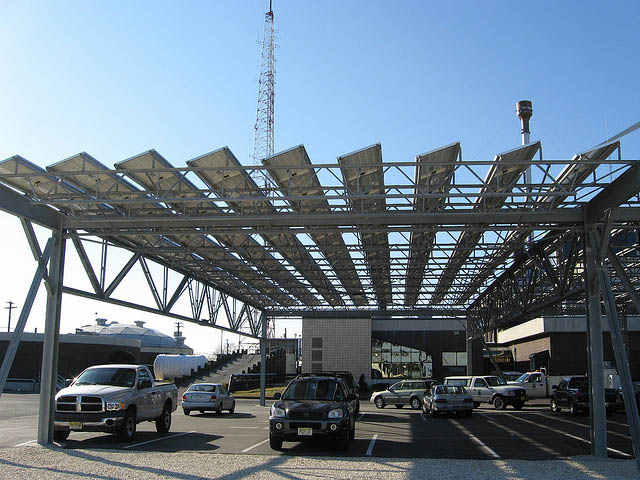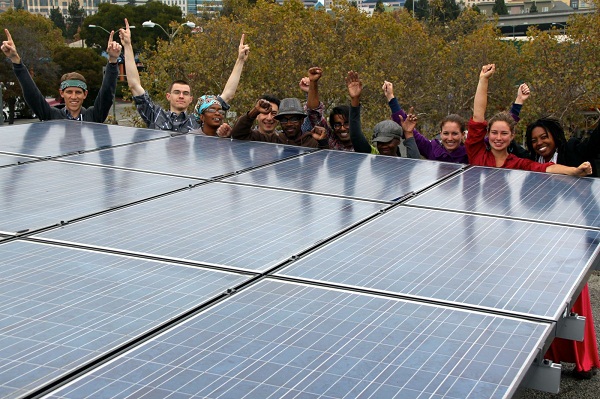In my years writing about energy it’s always the big projects that seem to excite people — both readers and the PR people pitching you stories for their clients. It’s hardly unnatural. A planned gigawatt-sized concentrating solar power plant, with a massive central tower, photographed (more likely Photoshopped) with rays of streaming potentiality bounced towards it by a veritable sea of of mirrors, is indeed a stirring sight.
But, in the words of E.F. Schumacher, small is beautiful — especially when it comes to solar power.

On rooftops, over parking lots, in backyards, on farms, on commercial rooftops, we need a massive build out of solar power — owned by individuals, cooperatives, small companies, not traditional utilities. Germany has already been doing this, where over half of its world-leading solar power capacity is owned by citizens and farmers. It’s here that we ought to be investing our time, energy, and resources before we go covering new land with solar panels and heliostats.
After all, unlike wind power (which is usually best well outside of densely developed areas), the sun shines equally well on top of places we’ve already built on, where we already live, work, and do business, as it does far away from where the power is needed.
Over 300 Gigawatts of Power Waiting on Our Rooftops – And That’s Just the Top 10 States
Just looking at the United States, recent research from the Solar Energy Industries Association shows that there’s huge rooftop solar power potential waiting to be tapped.
California leads the nation, with 76 gigawatts, just on the roof of buildings. Texas trails a bit with 60 GW — especially remarkable considering how much of the state, particularly in the western half is barely developed at all, much wilderness or rangeland. Florida has 49 GW of potential rooftop solar power; Ohio has 27 GW; Illinois 26 GW; Georgia and New 25 GW each; North Carolina 23 GW; Michigan and Pennsylvania each have 22 GW.
Right now, California is using a bit over a gigawatt of that potential, with some 626,000 homes having solar power. Arizona, the sunniest state in the nation, though not making the top-10 list of most solar potential (there’s a lot of largely undeveloped desert there…), has solar on about 139,000 homes, for a total of 710 megawatts.
Those are some really big numbers in total, but to bring them from the potential to actual, a huge amount of individual action must take place.
Even then, not all of that potential can easily be accessed, or accessed at all. Consider the case of New York City, where I live. There are thousands of rooftops without solar power here, just on the island of Manhattan, but just taking the residential ones, there are logistical hurdles to be leapt.
For example, my building, which has 24 separate apartments in it, wants to install solar panels. We even have the roof space to probably generate enough electricity for everyone in the building. But due to the way the electricity is metered in the building, a smaller system will be installed, enough to cover the electricity used in the common areas of the building and the exterior lights. There’s no way we could actually meter electricity right now for each unit, how much of the solar power we could produce was going to my apartment versus my neighbors.
But let’s not focus too much on these hurdles. More places in the nation won’t have my particular problem than will.
The point here isn’t to give an overview of everything you need to know to buy solar panels for your home. There are plenty of resources for that. But instead I want to highlight some interesting alternatives to just buying solar panels.
Getting Solar Power Doesn’t Mean Going It Alone
The first, one which I’ve been plugging for several years now, is solar power leasing, sometimes called solar-as-service. In such an arrangement, you contract with a company, which will assess your building and power needs for the best configuration of panels, and then install and maintain them. You pay for the company for the electricity the panels produce, not the panels themselves. Some programs have a buy-out option, where after a given period of time you have the option of purchasing or upgrading the system. It’s green power with little financial risk.
The second, pioneered by One Block Off The Grid, now owned by a Canadian company, allows homeowners to join together with neighbors (roughly speaking, they just have to be in the same area) to get preferential pricing from solar power installers. You own the panels from the start, just like if you were doing it all yourself, but get a better price.

Both of these options have been around for several years, and have been expanding, if not universally available yet. One really interesting convergence of small-scale solar power and crowd-funding has emerged recently. Oakland-based Mosaic urges us to “Create Solar Energy Together.”
Writing for Mother Jones, Kate Sheppard describes how Mosaic works:
“Investors contribute a minimum of $25 to a project. Over the next 5 to 10 years—depending on the project—the investors will make that money back, plus interest. The return on the investment ranges from 4.5 to 6.4 percent annually, depending on the project. They can support projects in any state, but right now only accredited investors and people in New York and California can invest in the projects, due to regulatory barriers in other states. In order to qualify, projects must be for organizations that are financially stable, have adequate insurance, and benefit the wider community in some way. Recent projects include affordable housing projects, a convention center, several nonprofits, a grocery store, and a Native American reservation.
Mosaic’s founders want to do for solar energy what Kickstarter has done for bands and independent films, or what Kiva has done for upstart projects in the developing world. But Mosaic’s model goes beyond most other crowdsourcing sites, by not only allowing supporters to invest in the solar project but also make a profit doing so.”
Decentralized Solar Power Even More Important in Developing Nations
If small-scale solar power is important in the wealthy nations of the world, where extensive electricity distribution is already present, and where the issue is converting a dirty power supply to a clean one, in developing nations there’s an even more urgent need for decentralized solar power.
In places where grid access is spotting, or an electricity grid is non-existent, there may be no need to build a grid at all — or at least a massive, nation- or region-wide one.
The problem in areas like this is, often, that people don’t have the money to purchase solar panels — or anything beyond a short term supply of whatever fossil fuel they are using for light and, if they are lucky, a generator.
It’s here that companies like Simpa Networks come in.
As they describe their work in India:
“Simpa’s customers make a small initial downpayment for a high quality solar home system and then pre-pay for their energy service, topping up their systems in small user-defined increments using a mobile phone. Each payment also adds towards their final purchase price. Once fully paid, the system unlocks permanently and continues to produce electricity. The technology is also offered to solar micro-grid developers as an extremely flexible prepaid metering, customer, and revenue management solution.”
As for the benefits that a green power supply can provide, just a very modest amount of electricity, check out this description from an NGO based in Benin of what the Solar Electric Light Fund has been able to do:
“In the Kalale district, SELF and ADESCA installed solar panels to power the Solar Market Garden in two villages, and construction is under way in eight more villages. Solar panels provide electricity for a pump attached to a deep-water borehole that sends water to a reservoir. The reservoir is located at the top of the garden, which is as large as a football field, and feeds up to 21 cubic meters (5,547 gallons) of water to the garden via drip irrigation. […] ADESCA solar technician Zacharie Sero Tamou explained, “During the dry season, families suffer nutritional deficiencies, which have a negative impact on child and adult health. The Solar Market Garden allows families to have fresh vegetables year round and improves the health of the children. Women can sell vegetables on the market and everyone is happy with this service.”
Small Is Still Beautiful, Even When It Ends Up Being Huge
The 20th century, particularly the latter half of it, was built on the mythology of big being best. Maximizing size, pleasure, speed, everything. It’s built into the psychology of capitalism in many ways, and into the collective consciousness of the United States in particular. It’s an essential element in consumerism as identity story, in the underpinnings of free trade, in many ways.
But in as many ways as bigger works, in more it fails. And in a time when the climate is changing before our eyes, when economies are failing (and the causes of that failure, unchecked free-market corporate-led capitalism, not even regularly acknowledged), when critical resources are running out or at least becoming more scarce and therefore more financially dear, smaller can often be better.
Smaller may not always be maximally efficient, but it well may be optimally efficient. It may not always being the most inexpensive, but it can be the most resilient. It is seldom the flashiest option, but in its humbleness, small is often the most elegant option.